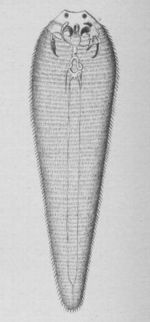| This article is still under construction. |
|
|
Introduction
The crustacea are a latge group of arthropods but are ususally treated as a subphylum. The majority of crustaceans are aquatic but some have adapted to terrestrial life.
There are only two species of parasitic crustacea of veterinary importance, the tongue worm Linguatula serrata and sealice Lepeophtheirus and Caligus spp.
Linguatula serrata
- Also known as the 'tongue worm'
Recognition
- Tongue-like appearance
- Expanded anteriorly
- Adults are over 10cm in length
- Females measure betwen 30-130mm in length
- Males measure up to 20mm in length
- Transversely striated
Life Cycle
- 6 month life cycle
- Adults inhabit the nasal passages of dogs and sometimes cats
- Eggs are expelled by coughing and sneezing or are passed out with the faeces
- Herbivorous intermediate hosts ingest the eggs
- Eggs hatch in the herbivore intestine
- Larvae migrate to the mesenteric lymph nodes and encyst to become infective nymphs
- Cysts measure 1mm in diameter
- When a dog eats infeced uncooked viscera the life cycle is completed
- Infective nymphs migrate from the viscera during chewing and crawl up into the nasal cavity via the soft palate
- Infective nymphs mature to adults in the nasal cavities and can survive for a year in the final host
Pathogenesis
- Causes rhinitis
- Heavy infection leads to coughing, sneezing and nasal discharge
